The Guillotine Choke is one of the most recognized (and most commonly used) techniques in grappling. The guillotine choke, and indeed the headlock itself, cannot be claimed originally by any one grappling art.
The technique has been depicted in ancient artwork, such as Greek vases dating back to the 6th century BC, and referenced in ancient texts that describe periods even earlier than that.
A 3000-year-old technique like the front headlock and the guillotine choke is still around because it works. Anatomically, grabbing a person’s head to control them is a great idea – even complete newbies will grab a headlock of some description in a fight.
Grabbing and controlling a person’s head and then squeezing their neck until they stop resisting is a simple concept when we think about all the possible existing techniques.
With that said, the guillotine choke and headlock are not without their nuances. I will demonstrate a few ways to apply an effective guillotine choke from a range of positions.
How To Do A Guillotine (Step By Step)
Step 1: Head & Arm
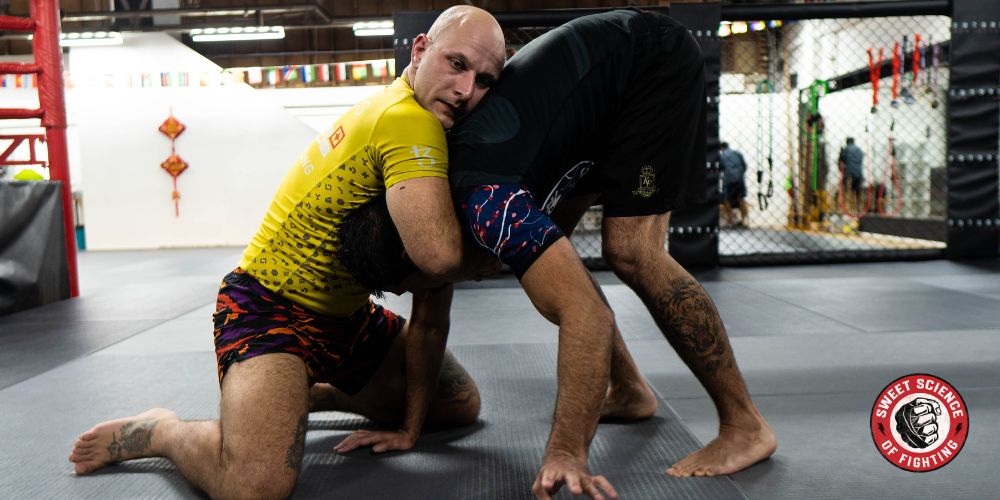
The first step is to wrap one arm flush against his neck and one over his shoulder. We can use this front headlock position to set up our guillotine.
Notice that my choking arm is flush with his neck, and my body is blocking his head to one side. I don’t want his head in the middle of my chest.
Step 2: Ground Your Opponent
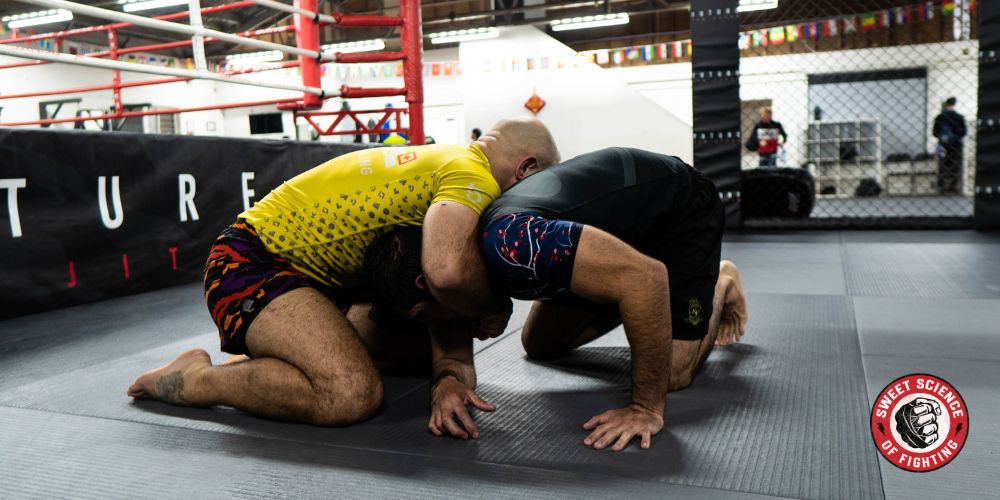
I drag my opponent down to his knees. This reduces his ability to escape by putting him in an unathletic position and kills his posture.
Step 3: Setting Up The Hand Position
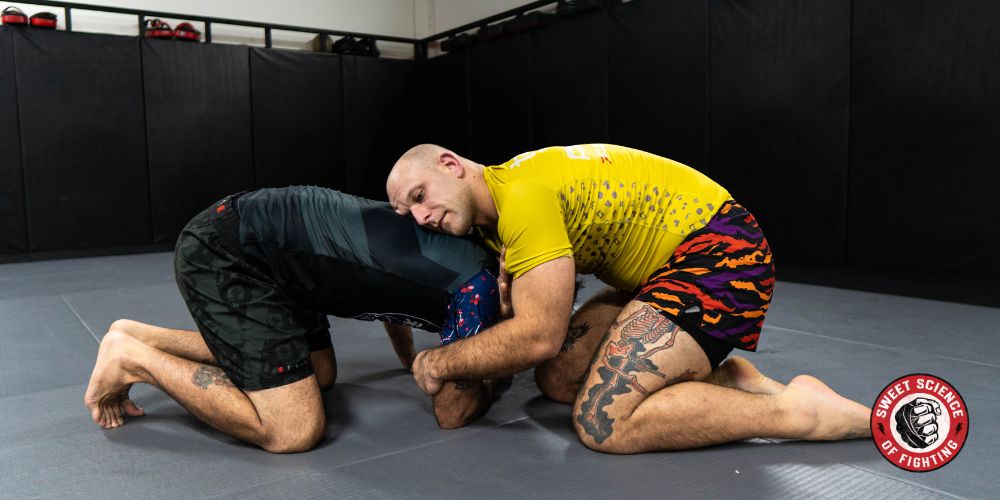
On the other side, I will take my hand controlling the shoulder and move this to secure my choking hand.
Step 4: Securing The Choking Hand
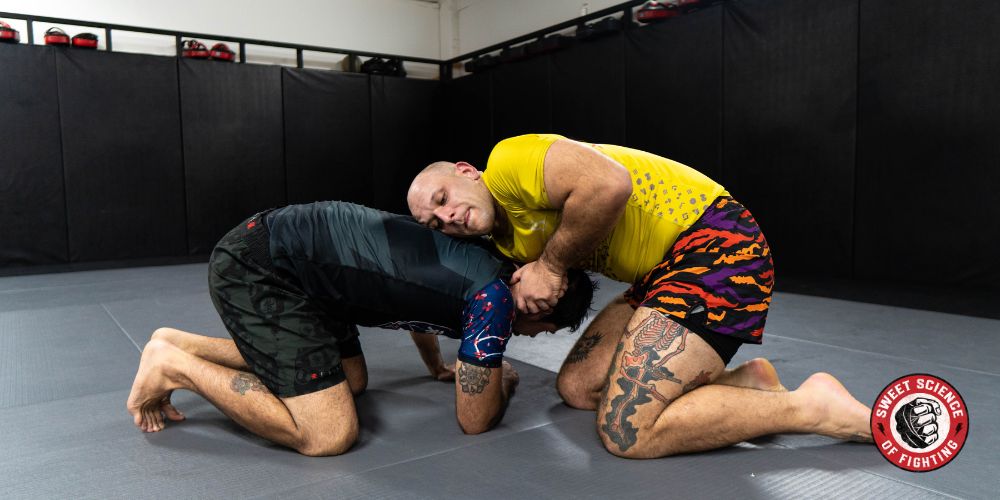
You can see that my hand has now moved in front of the shoulder. I connect my hands and secure my arm position to cinch in the choke.
5 Step Blueprint To Build A BJJ Strength Workout To Demolish Your Opposition
Learn how to plan your strength training to maximize transfer to the mats.
Step 5: Lift
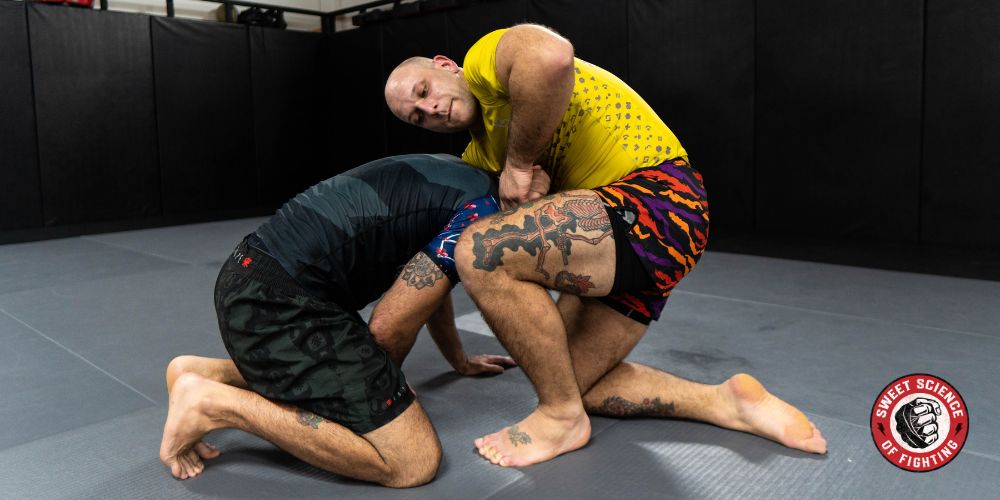
Now, take a step up with your outside foot. This will help you remove any space around their neck and allow you to make any last adjustments to your arm position or angle.
Step 6: Sit In
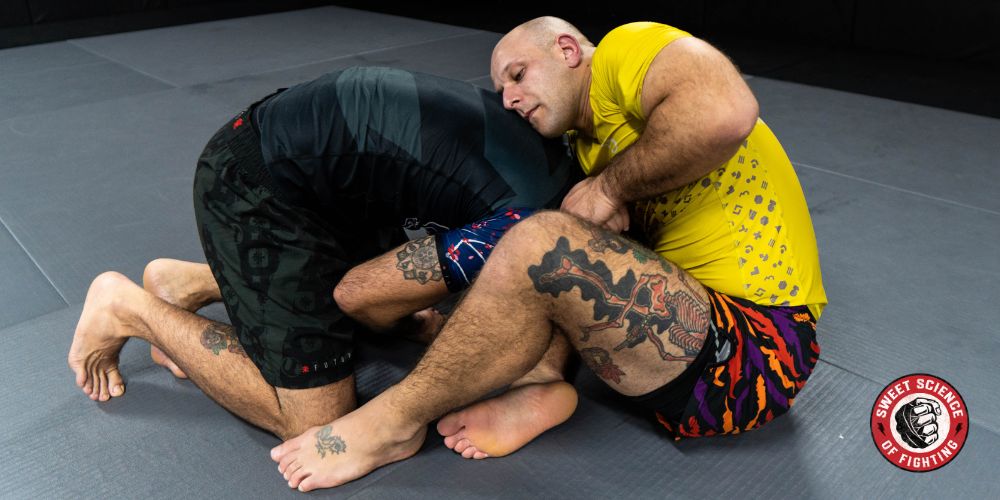
I sit in with my right hip and leg to trap his head to the side of my body. At this stage, you will start to generate strangling/ choking pressure.
Step 7: Fall & Hip Block
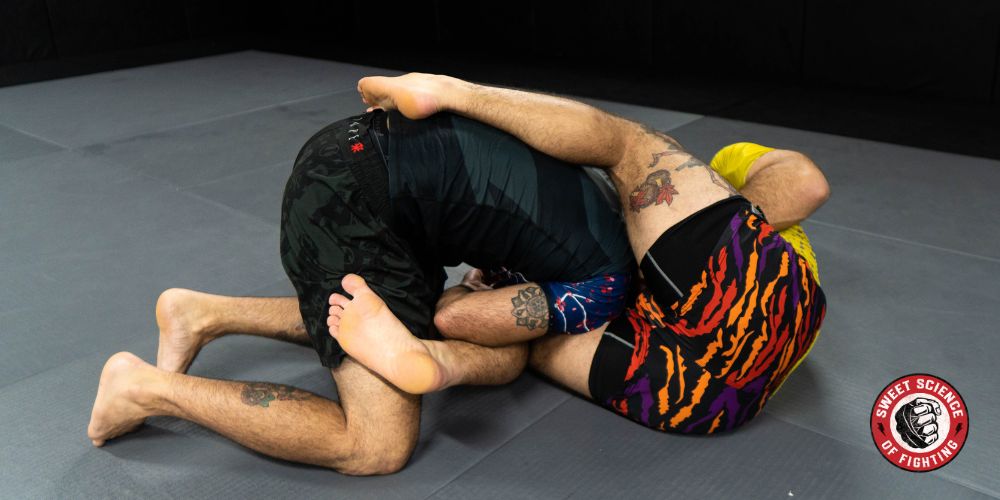
I make my final angle here by falling to my side and throwing my outside leg over his hips to prevent his escape. At this stage, provided you’ve made the correct adjustments and angles, your opponent will either be tapping or going to sleep shortly.
Guillotine Choke Grips
High Elbow Grip
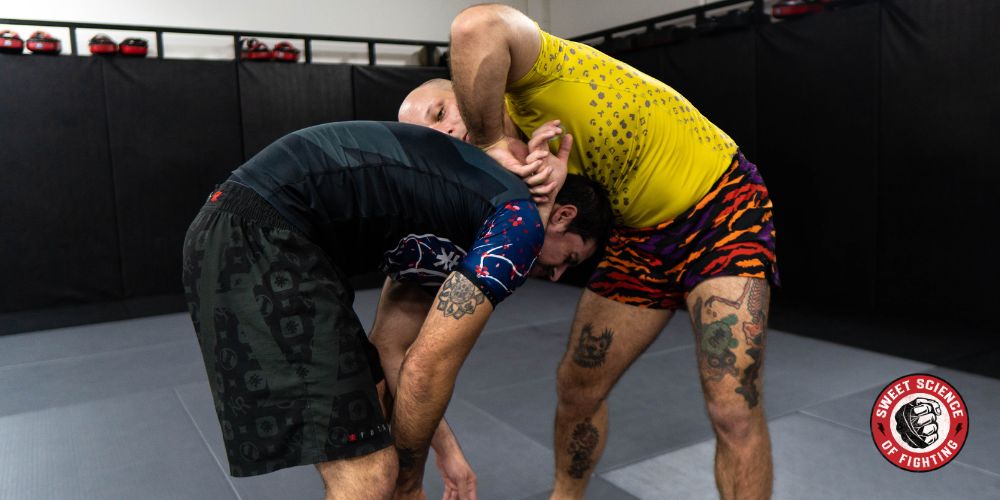
The high elbow is a popular grip for the guillotine. This requires me to drop my head and shoulder off to the side, allowing my arms to go deeper into the choke.
I can now flare my anchoring arm’s elbow behind his shoulder line, preventing several defensive reactions and generating a great strangle.
The Traditional Grip
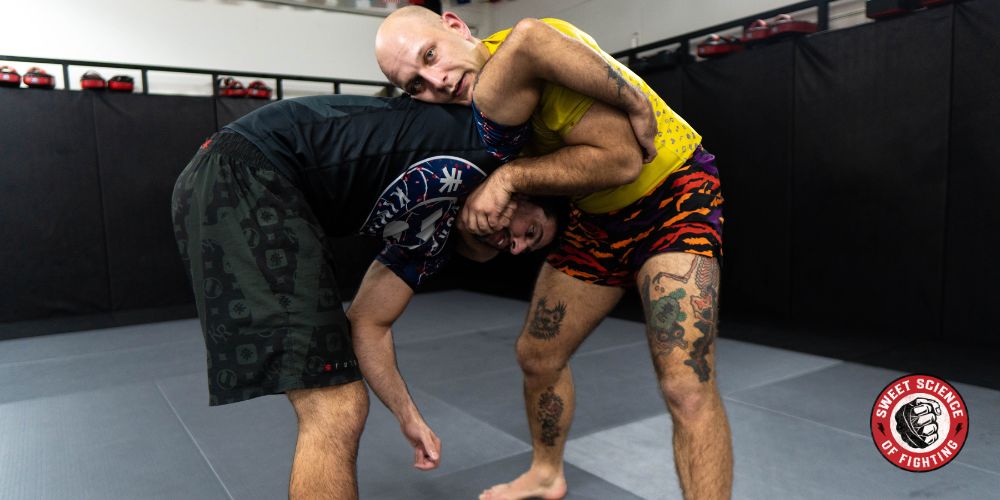
The traditional guillotine grip is where I place my anchoring hand directly over my choking hand to protect it. There are several reasons to continue using a traditional grip configuration, including wrist mobility, the ability to protect the fingers (which your opponent will be grabbing), and versatility.
The Ten Finger Grip
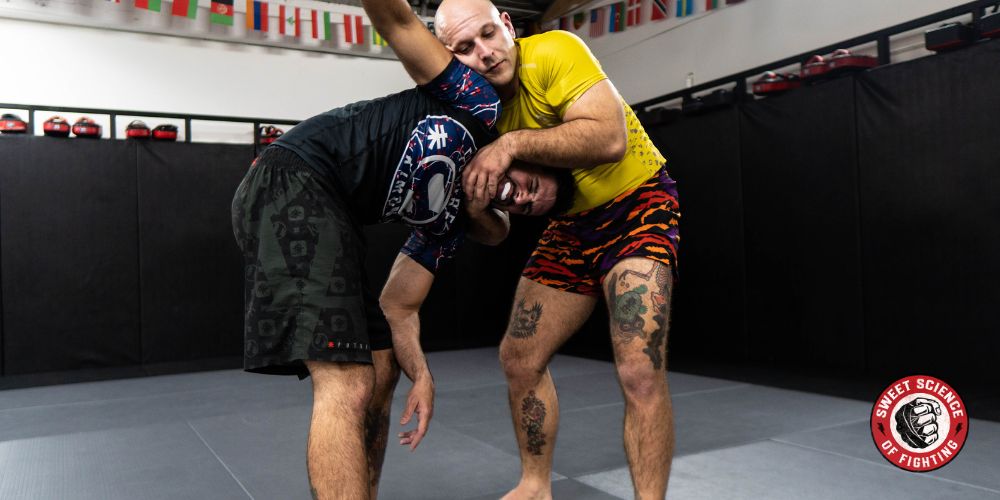
Another noteworthy grip is the ten-finger grip. This grip is certainly more of a choke than a strangle. It’s a short, sharp, and nasty grip best used to illicit movement from your opponent rather than doubling down for a secure finish.
How Does A Guillotine Choke Work?
Simply put, a good Guillotine is cutting off blood to your brain. A more rudimentary application of the guillotine can prevent your opponent from breathing, but the optimal outcome is to strangle them into unconsciousness, cutting off circulation in the neck.
When we angle our choking arm correctly, we can get flush up against our opponent’s neck on both sides. Once we apply pressure to both sides of the neck, we can close the arteries that send valuable blood to the brain. If our opponent doesn’t defend by alleviating that pressure or tap, they will go unconscious shortly.
Guillotine Choke Defense
There are some sound ways to escape the guillotine, but they first require you to fight the hands and center your head.
Fight The Hands
You must fight their hands if you find yourself in a headlock or guillotine. This means using your own hands to control the thumb line of your hands. Doing this will alleviate the pressure of the choke and create the space you need to center your head.
Centering Your Head
Don’t let your head get blocked to one side of the attacker’s body. This will lead to them developing more control over your neck and overall posture. You want to get your head into the middle of their chest while you fight the hands. From here, you can start to create angles for both of the preferred ways out.
The Drag
The drag is best executed when we can center our head and get one or both hands behind the elbow of the choking arm. From there, we cut an angle with our head away from the choking arm, dragging the arm by as we raise our head on the way out.
Guillotine Choke Variations
Standing Guillotine Choke
The standing guillotine choke is very similar to the arm-in process we walked through in the step-by-step above. The main difference is that we immediately go to two hands in front of the shoulders this time rather than collecting an arm-in headlock.
Break their posture, collect their head, and ensure your shoulder stays glued to the back of their neck. You no longer have the posture control you get from controlling a shoulder with the head and arm control, so this is a must. Connect your hands, and use the high elbow variation to cinch in the choke.
Frequently Asked Guillotine Choke Questions
Is The Guillotine Choke Legal?
Yes, the guillotine choke is legal in almost every rule set in BJJ and MMA. However, in certain wrestling styles, connecting your hands in the headlock or applying the choke is illegal.
What Happens If You Don’t Tap To A Guillotine?
With a Guillotine that is strangling you, you’re in for a nap time. With a guillotine that is choking, the feeling can be painful & unpleasant and even cause a gagging effect.
The nature of a guillotine is such that if you don’t tap, you can be put to sleep. It’s also important to remember that the neck is a relatively sensitive area, too, and the pressure from a guillotine could also cause potential injuries to your muscles or spine.
Can The Guillotine Choke Kill?
In short, yes. Any choke can kill a person if applied for a long enough time.
What Does A Guillotine Choke Feel Like?
Being guillotined is not a fun experience. There will likely be a sensation of building pressure when the strangle is applied. It will be difficult, if not impossible, to breathe, and you will almost certainly feel a strong desire to wrench your head free.
Depending on the guillotine type, it can also be very painful as the hands or arms dig into the sensitive areas around your neck, jaw, and face.
Summary
In summary, the guillotine is a highly effective technique that has been around forever yet still sees new innovations and interpretations. If you took 100 people and asked them to show you a headlock and a guillotine, you’d likely see 100 different-looking guillotines!
The Guillotine is used at the highest levels of grappling and MMA in the modern era, both as a tool to control the fight and to finish it. For a technique that predates written history or even formal grappling arts, I’m sure our ancient ancestors would approve of its modern applications.

